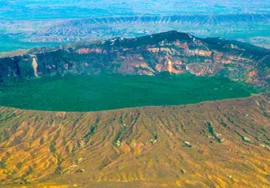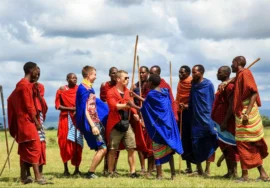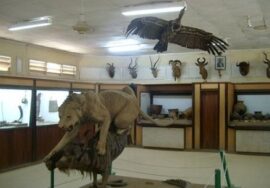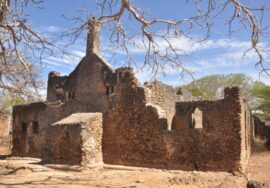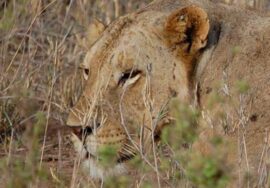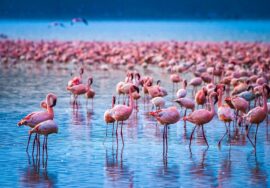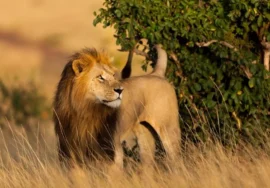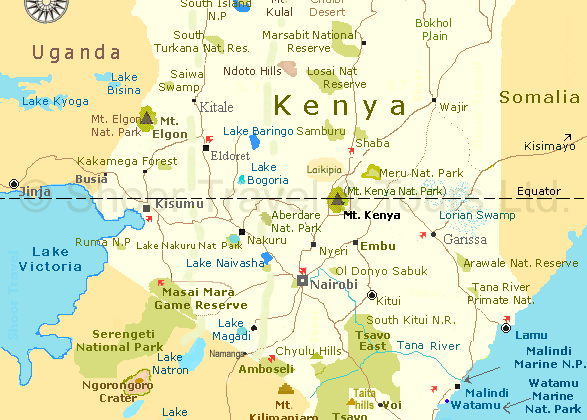
Kenya National Parks and Reserves
Aberdare National Park
The Aberdares are a highly forested mountain range that covers 766 km² and rises to over 4000m. To the north, you can see Mount Kenya, and to the south, you can see the Rift Valley. Rare Afro-montane forest grows in thick stands on the mountain slopes, and Afro-Alpine and sub-Alpine heath and groundsels grow in the high grasses.
Many of the views look more like those in Scotland than in Africa. The plateau is crossed by many clear streams and rivers that are all stocked with rainbow fish. As the rivers fall off the cliff, they form some beautiful waterfalls.
There are many kinds of animals that live on the hill. Some of the most common ones are the Suni, the Blue Monkey, the Colobus Monkey, the Giant Forest Hog, the Black Rhino, and the Elephant. Lucky people who go there might see the rare melanistic (pitch black) type of Leopard.
This is one of the last places where the highly endangered bongo can still be found. You can walk, but only with an armed guard because the Lions here are dangerous and have attacked people before.
Amboseli National Park
For Kenya, this park is pretty small. It’s just under 400 square kilometers and is in the middle of the border with Tanzania, 220 kilometers (136.7 miles) from Nairobi. Mountain Kilimanjaro’s snow-capped peaks can be seen in the background of the Amboseli fields, which is one of the most photographed views in Africa.
A system of swamps and marshes makes it possible to see wildlife all year long. The park is home to 425 bird species and 56 animal species, such as the Lion, Leopard, Cheetah, Elephant, Hippo, Black Rhino, Maasai Giraffe, Gerenuk, and Zebra.
The Laikipia Plateau
The Laikipia Plateau goes from Mount Kenya to the edge of the Great Rift Valley. It is between the north Kenya sands and the Aberdare Mountains. Some of the nicest camps in Kenya are in this area, which became popular thanks to Kuki Gallman’s book I Dreamed of Africa.
“The place looked like a mirage to the tired traveler—it was full of wildlife and green with pastures, rolling hills, rivers, and springs.” The book I Dreamed of Africa by Kuki Gallman. There are a lot of plains game and rare predators, like the caracal. If you’re lucky, you might even see the shy aardvark and aardwolf on a night drive.
Masai Mara National Park
In the southwest corner of the country, 390 km (242.3 mi) from Nairobi, there is a large, rolling plain below the Mara cliffs. Every year, millions of wildebeest and zebra migrate north from the Serengeti plains and leave the fields black. The reserve’s resident lions lie out in the sun during the migration season, which is July and August. They look fat and at ease. In the area, there are 13 tent camps and 2 lodges.
Maasai people who live on the edges of the reserve are co-owners of the reserve and share in the money that comes in from tourists. This 1,672km² area is home to all the big game species and is one of the best places to see wildlife in Africa. Along with the usual safari activities, you can also fly across the fields in a hot air balloon, which is one of the best ways to see wildlife in Africa.
Meru National Park
400 km from Nairobi, this 870 km² park is one of the least visited and least changed in Kenya because it is not on the main tourist route. George and Joy Adamson made the park famous by letting Boy, the son of Elsa the leopard (from “Born Free”), run free there. As ‘The Spotted Sphinx’ says, Joy taught Pippa, the cheetah, how to live in the wild again.
The Tana River, which is the biggest in Kenya, flows next to a small part of the park in the east. Adamson’s Falls, which are at the park’s very end, are a beautiful sight after it rains. Along with all the normal big game (except rhino), this is a great place to see the reticulated Giraffe and the Gerenuk, which is also called the Giraffe-necked Gazelle.
The white rhinoceroses were brought back to this area, but thieves killed them in 1988. Since then, security has become a lot tighter, and hunting has almost stopped.
Mount Kenya National Park
It is home to Mount Kenya (1,600m–5,199m), which is the highest mountain in Kenya and the second highest mountain in Africa. Mount Kenya National Park is about 193 km (119.9 miles) northeast of Nairobi, in the central highlands, in the districts of Nyeri and Meru.
The park covers an area that is above 3,200m. The icy tops of Mount Kenya reach a height of 5,100m and are right on the equator. Because it is right on the equator, a strange type of plant that looks like a Giant Rosette grows there.
People often call these plants “water holding cabbage,” “ostrich plume plant,” or “giant groundsel.” When you see them for the first time, they are really amazing. In general, there is a lot of alpine and subalpine vegetation, as well as bamboo woods, moorlands, and tundra.
In the bamboo forest and lower forest, you can find the giant forest hog, the tree hyrax, the white-tailed mongoose, the elephant, the black rhino, the suni, the duiker, and the leopard. In the moorland areas, you can find animals like the Mount Kenya mouse shrew, the hyrax, and the duiker.
It is common to see the native mole-rat at higher elevations, and the golden cat has been seen very rarely. Along the edges of the Park, you can see Elephant, Buffalo, Antelope, Lion, and the very rare Bongo. The best spot to see wildlife is on the south side of the mountain.
These months are the best to visit: January and February, and late August through September.
Nairobi and the Area
Nairobi is one of the biggest cities in Africa. It has between 1.5 million and 3 million people living in it, based on how much land you count. The city has a long and interesting past. It turned 100 years old in 1999. Nairobi began as a town built so that the East African Railway Line from Mombasa to Kampala in Uganda could be built.
The Maasai people who lived there called it enkare nyarobi, which means “the place of cold water.” A few years later, the settlement had to be rebuilt from scratch because the old town burned down because of the plague.
By 1907, the area was well-established and colonized with Europeans living there. It was then named the capital of “British East Africa.” Most people don’t stay in town for more than two nights before going on adventure.
When you first see the city, it seems like a crazy, chaotic mess, and the drive in general is very bad. There is, however, a lot to see and do while you’re there.
Samburu National Park
The hot and dry northern part of Kenya is home to Samburu National Park, which is 325 km (201.9 miles) from Nairobi and 55.9 miles north of Mount Kenya. It takes up 165 square kilometers of land in the park. The park has a constant water source in the form of the Ewaso Ngiro River, which starts in the Aberdares and flows through it.
Even though Samburu doesn’t have as much wildlife as some southern parks, the park’s beautiful scenery more than makes up for it. Because there is always a lot of water in the river, the sides are lined with a lot of different kinds of woodland plants. In this area, there is acacia forest with bushland, grassland, and scrubland.
It is home to many animal species that are rarely seen anywhere else. A few of these are the Somali Ostrich, the gerenuk, the Beisa Oryx, and the Grevy’s zebra. These animals can only be found north of the equator. There are a lot of different kinds of birds in Samburu.
Crocodiles are common and can be seen around almost every bend in the Ewaso Ngiro River’s sand banks. Hippos are often seen further downstream, where permanent pools have formed. Elephants roam the areas with a lot of thorns and seek comfort in the Ewaso Ngiro’s weak water. Rhino no longer live in the area because they are being killed for their horns.
Tsavo National Parks
This park covers 21,000 square kilometers, making it Kenya’s biggest. However, a lot of the eastern part is off limits to visitors. Buffalo, Lion, Antelope, Gazelles, Giraffe, and Zebra live on most of the land, which is mostly open savannah and bush forests.
Even though the number of elephants dropped sharply in the 1970s, there are still a lot of big groups. The Tsavo National Park has both dramatic cliff-face landscapes and the wild, untamed feel of one of Africa’s best wilderness places.
One of the best places to see crocodiles and hippos is at Mzima Springs in Tsavo East. Every day, 500 million liters (110 million gallons) of clear water pop up from the ground here. Mount Kilimanjaro’s snow melts into the spring, and Mombasa gets a lot of its drinking water from a tunnel that runs from the springs to the city.
A wildlife film group built an underwater glass cage that makes Mzima stand out. Here, you can go down a flight of stairs and watch groups of tilapia and the odd crocodile or hippos swim by from behind a glass wall.


